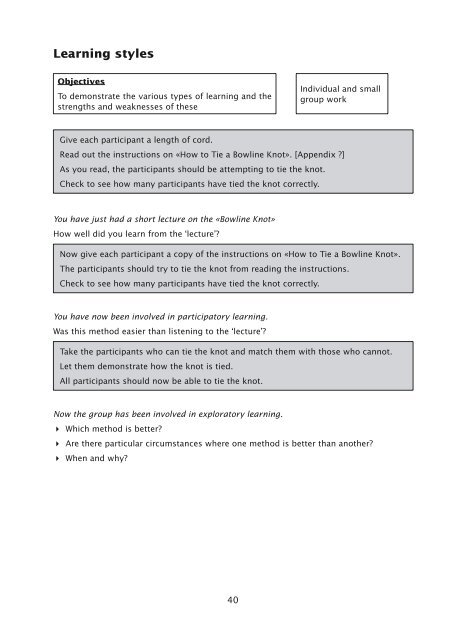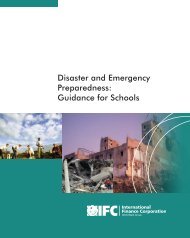Manual for training of facilitators (community component ... - INEE
Manual for training of facilitators (community component ... - INEE
Manual for training of facilitators (community component ... - INEE
You also want an ePaper? Increase the reach of your titles
YUMPU automatically turns print PDFs into web optimized ePapers that Google loves.
Learning styles<br />
Objectives<br />
To demonstrate the various types <strong>of</strong> learning and the<br />
strengths and weaknesses <strong>of</strong> these<br />
Individual and small<br />
group work<br />
Give each participant a length <strong>of</strong> cord.<br />
Read out the instructions on «How to Tie a Bowline Knot». [Appendix ]<br />
As you read, the participants should be attempting to tie the knot.<br />
Check to see how many participants have tied the knot correctly.<br />
You have just had a short lecture on the «Bowline Knot»<br />
How well did you learn from the ‘lecture’<br />
Now give each participant a copy <strong>of</strong> the instructions on «How to Tie a Bowline Knot».<br />
The participants should try to tie the knot from reading the instructions.<br />
Check to see how many participants have tied the knot correctly.<br />
You have now been involved in participatory learning.<br />
Was this method easier than listening to the ‘lecture’<br />
Take the participants who can tie the knot and match them with those who cannot.<br />
Let them demonstrate how the knot is tied.<br />
All participants should now be able to tie the knot.<br />
Now the group has been involved in exploratory learning.<br />
4 Which method is better<br />
4 Are there particular circumstances where one method is better than another<br />
4 When and why<br />
40

















